|
Co-sponsors of the 2023 Winning Out
Certificates


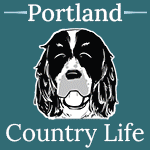
| |
A landmark occasion
for working dogs
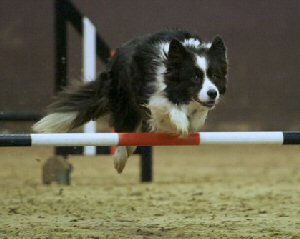 The
inaugural FORWARD Symposium took place on Sunday, 31st January at the
Wildwood Golf & Country Club in Surrey, organised by the well known veterinary
referral practice, Fitzpatrick Referrals. The event set out to cover the
conditioning of sports dogs and injury prevention, how to prepare for
competition and keep dogs injury free, and what options are available when it
all goes wrong. Jackie Bromwich reports on great day, with brilliant speakers -
Prof. Noel Fitzpatrick, Natasha Wise and Dr. Chris Zink from the USA. The
inaugural FORWARD Symposium took place on Sunday, 31st January at the
Wildwood Golf & Country Club in Surrey, organised by the well known veterinary
referral practice, Fitzpatrick Referrals. The event set out to cover the
conditioning of sports dogs and injury prevention, how to prepare for
competition and keep dogs injury free, and what options are available when it
all goes wrong. Jackie Bromwich reports on great day, with brilliant speakers -
Prof. Noel Fitzpatrick, Natasha Wise and Dr. Chris Zink from the USA.
This event had
proved to be very popular, and tickets sold out quite quickly. It was great to
see so many agility people attending, even if it proved a little tricky to
identify people when they were all dressed up, rather than in the usual garb of
running gear. Thank goodness for name badges! The organisers had thoughtfully
provided a well marked out area to exercise dogs, with water and poo bins
available in abundance.
There were three key speakers. Dr. Christine
Zink is a veterinarian and a consultant on canine sports medicine, and an author
of several books on conditioning, training and rehabilitation, as well as being
a successful handler and competitor in her own right in various sports.
Professor Noel Fitzpatrick has treated working dogs throughout his career and is
one of the leading orthopaedic and neuro-surgical specialists in the UK,
and is also the Principle of the Fitzpatrick
Referrals Sports Medicine and Rehabilitation Facility.
Agility’s very own Natasha Wise
needs no introduction, but is a triple World Champion, a prolific winner of many
finals, including Olympia no less than six times, and has an MSc in Sports
Science.
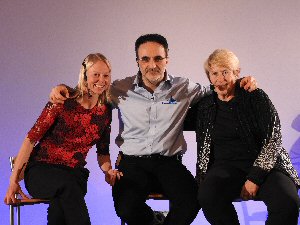 Morning
session Morning
session
The day kicked off with an introduction
by Noel Fitzpatrick, in which he acknowledged the love, and the strong bond
between performance dog and handler, and the recognition that sports dog
handlers generally have an excellent working knowledge of their dogs, and that
the veterinary profession do not always appreciate the importance of this.
The first main
speaker was Chris Zink, and she introduced herself as being 'one of us' – a dog
handler. She started by showing a spectacular slow motion video to illustrate
what can go wrong when a dog is competing, and how easy it is for injuries to
occur. In most cases, the incident was so quick, that the handler may not have
been aware of just what happened to the dog, particularly when the dog picked
itself up and carried on. She emphasised that accidents happen, but that
conditioning aids injury prevention – a dog that has good musculature and
excellent physical condition and core strength will be less likely to be injured
when things go wrong.
She discussed
the idea of a complete physical assessment of a young dog before starting
training, and identifying the dog’s individual physical strengths and weaknesses
in order to plan a conditioning programme to target these, and talked about the
various options available to incorporate into a plan for each dog, with video
illustrations. She also covered the importance of a correct warm up and cool
down for dogs prior to training or competing – something that is often
overlooked by many competitors.
Natasha started
her talk with emphasis on the longevity of her dogs. Her first Agility Champion,
Maddie, was nine years old when Championship classes came into being, and won
her final agility certificate at eleven and a half years. Dizzy is still
competing at World Championship level at nine years of age, which is a tribute
to Natasha’s care for her dogs and the successful training and conditioning
programme that she employs to keep them fit. She discussed the importance of
treating all dogs like athletes – the work they do makes them far more than just
a pet, and the fact that all sport involves risk, therefore you need to minimise
risk to the dog by conditioning, prevention and performance.
She talked about
sports science, and how goal setting can help handlers, and the importance both
of identifying weaknesses and training to them, and of focussing on controllable
factors. She explained how she creates her own annual training plan, and the
importance of a phased training programme incorporating conditioning, skills
training, obstacle focus and sequencing, varied to suit the phase of training
each dog is at. She feels that every dog only has so many jumps in them, so
handlers need to use them wisely, and target training and competition
appropriately to maximise results and minimise risk.
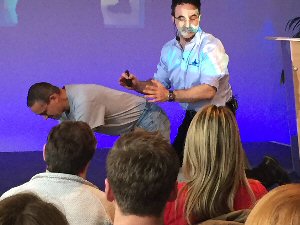 Noel
Fitzpatrick was the last speaker before lunch, and again emphasised the love
that the handler has for their dog, and the fact that agility handlers are often
much more aware of potential problems and are more likely to investigate
potential issues earlier than many pet owners might. Noel
Fitzpatrick was the last speaker before lunch, and again emphasised the love
that the handler has for their dog, and the fact that agility handlers are often
much more aware of potential problems and are more likely to investigate
potential issues earlier than many pet owners might.
He talked about
lumbosacral problems – something that he felt was the most under-diagnosed
condition in agility dogs and the importance of differentiating between a disc
leak and a disc bulge. If a dog has a disc leak, the last thing that handlers
want to be doing is taking the dog to a chiropractor for manipulation. The
importance of dynamic MRI was also emphasised, positioning the dog appropriately
as disc bulge may be evident with the spine in extension, as it would be during
jumping, but not in a neutral spinal position. Much hilarity greeted his
demonstration of a clinical examination for lumbosacral problems, with well
known agility vet, Peter Van Dongen, very ably playing the part of the
unfortunate dog!
Also covered
were hip problems, and the pros and cons of the hip scoring scheme, along with
the fact that hip dysplasia can often be managed successfully in early life, but
only for a limited period if the hips were bad . In later life, intervention was
often necessary, and he discussed the available options such as conservative
management and surgical options. He also covered cruciate ligament ruptures, and
the importance of looking inside the joint to see what damage had occurred to
cartilage – something that not all vets do. He also stressed that misdiagnoses
can occur and showed a radiograph of a dog that had undergone TPLO surgery, but
the bone tumour that was present had been missed. His words were 'Don’t miss
tumours.'
There was a short break for lunch and to
enable attendees to let dogs out, if they had them in their vehicles, although I
suspect that a large number of delegates spent a good part of their lunch break
queueing for the loos. It probably helped everyone feel very much at home as
queuing is something that all agility handlers are, of course, well used to.
However, this was the only real grumble that people seemed to have and I am sure
that this was an unavoidable teething problem and will be rectified next time
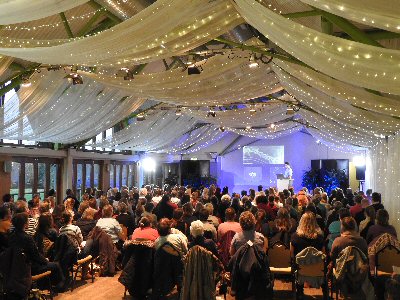 After
lunch After
lunch
The afternoon continued with talks by
all three speakers. Chris Zink put the emphasis of her second talk on tips and
tricks for early identification of injuries, and I found this particularly
useful. She showed the importance of video analysis for lameness evaluation,
looking at jumping techniques and weave pole performance. A change in a dog’s
weave technique can often be the result of an injury and subsequent reluctance
to use that limb fully. Slow motion video analysis of the weaves on a regular
basis through the season can often pick up a change in performance before
clinical signs are shown. She also emphasised the importance of a definitive
diagnosis before embarking on any treatment or rehabilitation plan.
Natasha’s second
talk was about returning dogs to work following an injury, and the importance of
a gradual reintroduction to agility. She also discussed the fact that many vets
do not understand exactly what agility entails, and may advise that the dog can
return to competition much sooner than is advisable. She gave examples of a rest
and return to activity plan for one of her own dogs following spaying.
Natasha also
covered the importance of a planned warm up and cool down when training and
competing, and as a discussion item towards the end of her talk, the vital
importance of ensuring that a healthcare practitioner is suitably qualified and
competent to treat dogs. To illustrate this, she detailed the tragic
circumstances surrounding the loss of her own precious young dog following a
hydrotherapy session, something that was very brave of her to share with us.
The last speaker
of the day was Noel Fitzpatrick who covered thoracic limb lameness. He used case
studies to illustrate the difference between nerve problems, potential tumours
and joint issues, and the fact that there can be solutions to nerve problems –
even a broken neck does not necessarily mean euthanasia. He discussed shoulder
pathologies, and the many different solutions for OCD – a common condition of
working collies. Case studies were used again to show the different elbow
problems, and solutions that were available, and the importance of bearing in
mind that there were elbow pathologies which would be evident on CT, but not
necessarily show on radiographs, and that arthroscopy is the gold standard of
investigation of elbow problems.
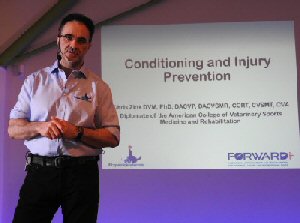 There
was a short question and answer session at the end of the day, with lots of
people keen to ask questions. All speakers were informative and entertaining,
and I think that everyone went away with something useful to fit into their own
training programmes. There
was a short question and answer session at the end of the day, with lots of
people keen to ask questions. All speakers were informative and entertaining,
and I think that everyone went away with something useful to fit into their own
training programmes.
The whole day was very well organised with a
friendly team ready to help anyone who had any queries. It was a first for the
practice, but there are plans for it to be an annual event. Talking to various
people afterwards, most really enjoyed their day, and felt that they had learned
a great deal. I think that future events would be a welcome addition to the
agility calendar, and personally I would mark the day with 10 out of 10. It was
a great day!
Thanks to Lesley
Hildrew and to Fitzpatrick Referrals for providing the photos.
About the author...
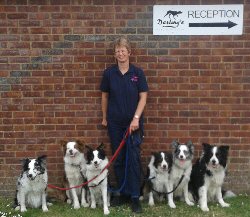 Jackie
Bromwich
first became involved in agility in 1984, and
has been breeding Border Collies under the Foxtwist affix since 1987. Jackie
Bromwich
first became involved in agility in 1984, and
has been breeding Border Collies under the Foxtwist affix since 1987.
She has competed and judged at all levels in
agility up to and including Grade 7, and has qualified with several different
dogs for most of the major finals over the years, with the exception of Olympia,
where she has always failed at the semi-finals due to terror and subsequent poor
handling! One of her biggest agility challenges over the years was training four
dogs with prosthetic limbs, and their owners, to complete an agility course in
just a few hours for the Supervet TV programme in 2015.
She is also a Championship show judge of
Border Collies in the breed ring.
Jackie worked for many years in a veterinary
practice as a qualified Behaviour Counsellor, but had a change of direction four
years ago and currently works as a Team Manager for the raw feeding company,
Honey's Real Dog Food.
She currently has seven dogs and has always
enjoyed the challenge of running multiple dogs in agility, but now she is
getting older, feels that she would be doing much better if she could run as
fast as she could 20 years ago!
First published 24
February 2016
| |
|